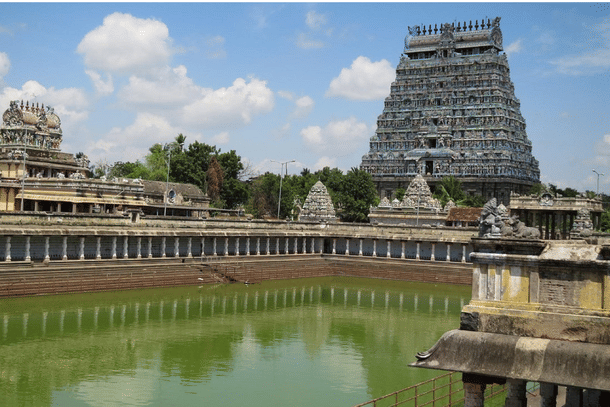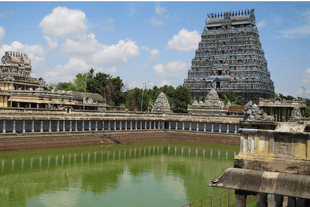News Brief
Explained: Legal Status Of The Chidamabaram Temple
S Rajesh
Jul 02, 2023, 10:59 AM | Updated 10:59 AM IST
Save & read from anywhere!
Bookmark stories for easy access on any device or the Swarajya app.


In this article, we attempt to give you a simple explanation of the legal status of the Nataraja temple at Chidambaram, which has been in the news recently over temporary restrictions on darshan from the Kanagasabhai mandapam during the Aani Thirumanjanam festival.
We are breaking down the issue into a question answer format for ease of understanding.
Who Are The Dikshitars Or The Podu Dikshitars?
They are a small endogamous Brahmin community who today number around 1500. They have been carrying out the rituals as well as the administration of the temple.
Are the Dikshitars a religious denomination?
Yes. This was said by the Madras High Court in Marimuthu Dikshitar vs. State of Madras and Devaraja Shenoy vs. State of Madras.
It was also said by the Supreme Court in the Shirur Mutt case.
What Is The History Of The Cases Filed Against Government Control Of The Temple After Independence?
After the enactment of the Madras Hindu Religious and Charitable Endowments Act 1951, a notification ( G.O.Ms.894 dated 28.8.1951) was brought to bring the temple under government control and an Executive Officer was appointed.
This was challenged by the Dikshitars by filing Writ Petition nos. 379-380 of 1951.
The Madras High Court quashed these notifications of the government. It held the Dikshitars to be a religious denomination and their position vis-à-vis the temple as analogous to Muttadhipati of a Mutt. It said that the notifications of the government violated Article 26.
The state government appealed against this order in the Supreme Court but the case was dismissed on 9.2.1954 as the state government itself withdrew the notifications.
After this there was an important case called the Shirur Mutt case and the 1951 Act was repealed by the 1959 Act.
While Section 45 of the 1959 Act empowers the state government to appoint an Executive Officer to administer the religious institutions, Section 107 states ‘Act not to affect rights under Article 26 of the Constitution).
Based on the 1959 Act, in 1987, the HRCE Commissioner appointed an Executive Officer for the administration of the temple.
The Dikshitars challenge to this was filed in the same year and the Madras High Court ordered a stay. However, it later dismissed the Dikshitar’s petition in 1997.
The 1997 dismissal was challenged by the Dikshitars who were then asked in 2004 to file a revision petition before the state government on the grounds that the Dikshitars had not exhausted all statutory remedies granted to them.
The revision petition was dismissed by the state government in 2006. The government defended its decision to appoint an Executive officer. It said that the order did not violate Article 26 and that the Dikshitars had not been removed from the temple.
The Dikshitars appealed against this decision in the Madras High Court. A single judge bench in 2009 and later in the same year, a Division Bench said that whether the Dikshitars are a religious denomination or not is not res judicata, i.e., had not get finality.
The appointment of the Executive Officer was held to be valid by the single judge bench and this was upheld by the Division Bench. It was said that the Dikshitars did not have the protection of a denominational temple in the matter of administration.
An appeal was filed against this decision in the Supreme Court and it was heard by a bench of Justices BS Chauhan and SA Bobde.
The question of whether the matter is res judicata was examined by the bench. Those opposing said that it could not be held so because the temple was neither owned nor established by the Dikshitars and thus the right under Article 26 (d) (to administer such property in accordance with law) would not apply to them.
The bench held that the matter of whether the Dikshitars are a religious denomination or not could not be enquired into by the High Court now and the matter is res judicata, i.e., finally decided as the matter was not heard again by the Supreme Court in the 1950s (as the state government’s appeal was dismissed because it had withdrawn the notification). i.e., the Madras High Court judgement in Marimuthu Dikshitar vs State of Madras would be final.
(The judgement also mentions that the Supreme Court had called the Dikshitars a denomination in an observation in the Shirur Mutt case.)
Thus, they would be entitled to the rights of a religious denomination and they could continue administering the temple. It quashed the appointment of the Executive Officer.
It also said that the government could appoint an Executive Officer only in the case of mismanagement and the Officer’s duties must be laid down by the HRCE Commissioner and the said appointment could only be for a specified period of time.
How Is The Temple Administered Today?
The temple today is administered by a committee of nine Dikshitars who are headed by a secretary. Major decisions are taken by a general assembly of the Dikshitars.
(For the sequence of cases, the author referred to the Supreme Court judgement in 2014)
Are The Dikshitars The Owners Of The Temple?
An article on the website of the Temple Worshippers Society and a recent letter issued by the titular Maharaja of Vijayanagar has details about the issue.
The article lists references in historical records calling the Dikshtars as owners of the temple. Some of them are as follows-
“The Pagoda is the property of a class of Brahmins known as Dikshadars” – Manual of South Arcot District by J H Garstin M.C.S., Collector of South Arcot District (1878)
“The pagoda is the property of the class of Deecshita Brahmins” –Glossary of the Madras Presidency by C.D. Maclean (1893)
It also states that two judgements of the Madras High Court, i.e., Marimuthu Dikshitar vs. State of Madras (1952 (1) MLJ 557) and Devaraja Shenoy vs. State of Madras (1952 (1) MLJ 481) state the same.
The letter released by the Krishna Devaraya, the titular head of the erstwhile Vijayanagar empire, states, “When the kings built temples, they built the temples for specific sampradayas and offered the temples to said sampradaya followers. The temples were administered by these denominations and the rulers did not own or control or administer the temple. Several inscriptions with donations end with phrases like Srivaishnava Raksha, Maaheshvara Raksha etc. to specifically emphasize the fact that the temples belonged to a specific denomination and that the denomination shall administer & protect the particular temple.
“Once donated, the property does not remain public property. It belongs to the specific denomination.”
S Rajesh is Staff Writer at Swarajya. He tweets @rajesh_srn.





